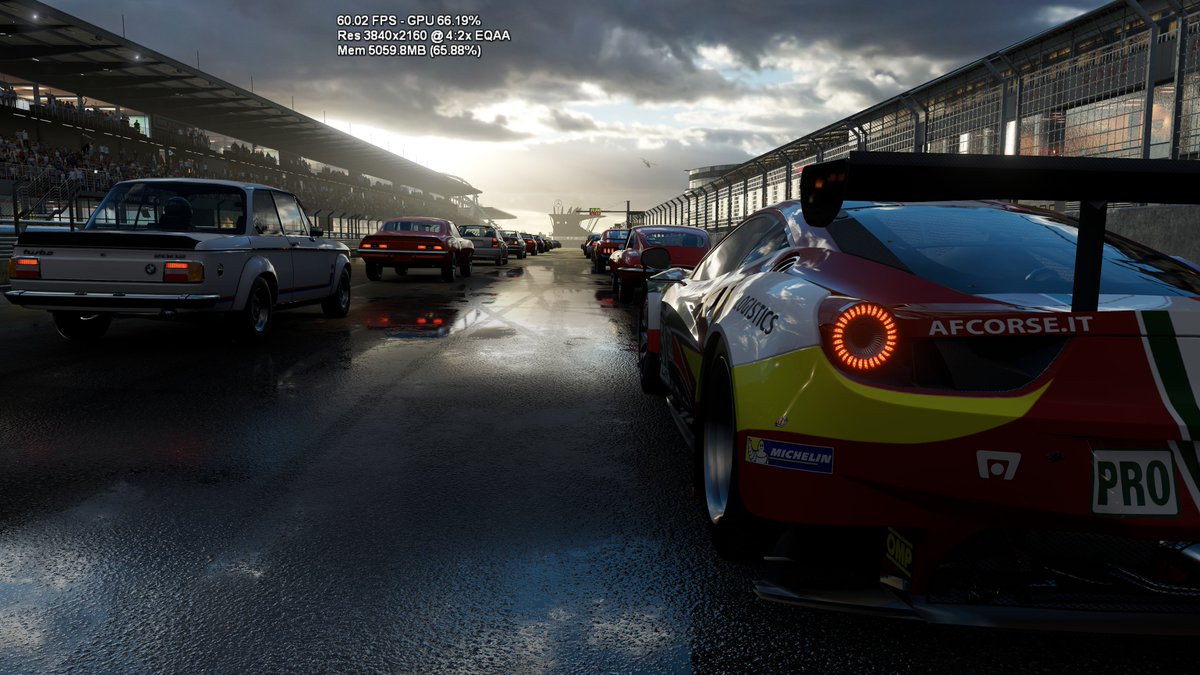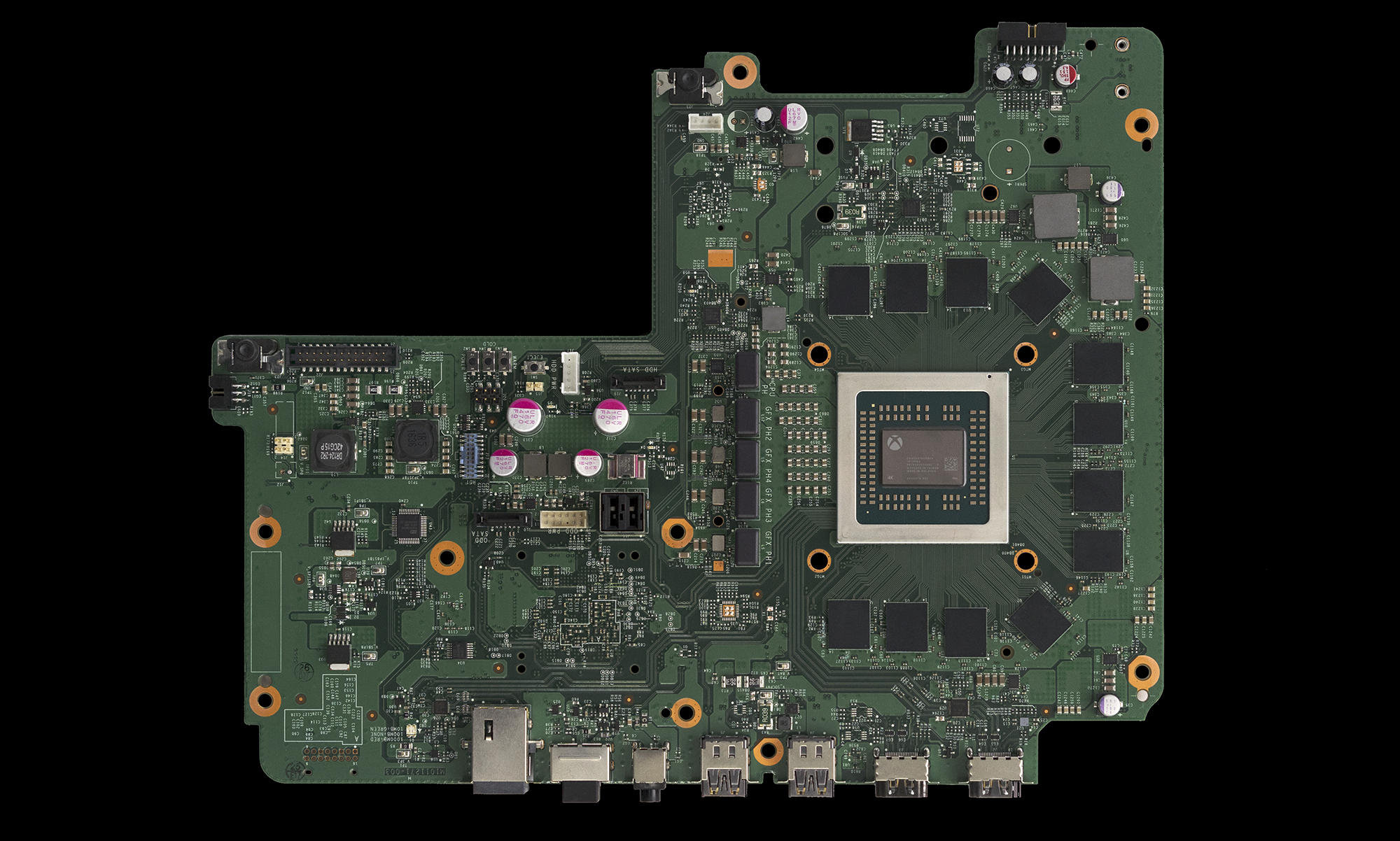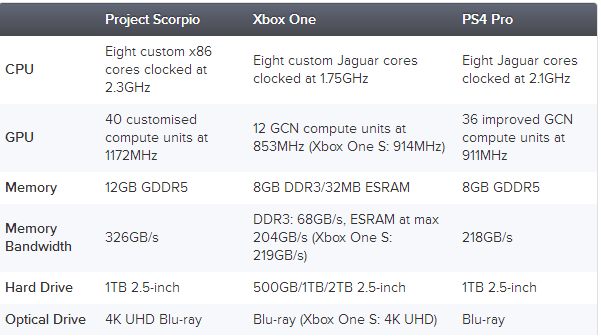LelouchZero
Member
Project Scorpio Exclusive: Final Specs Revealed! (Video)
5 Ways Scorpio Improves Your Xbox One and 360 Games! (Video)
Project Scorpio: Forza/Turn 10 Report + Analysis! (Video)
Articles
Inside the next Xbox: Project Scorpio tech revealed.
Scorpio made simple: the next Xbox's tech explained.
Scorpio is console hardware pushed to a new level.
Hardware
CPU - 2.3GHz custom eight core CPU (Supposedly "Jaguar Evolved").
GPU - 2560 cores at 1172MHz, 6TF.
Memory - 12GB GDDR5 with 326GB/s memory bandwidth.
This is Forza Motorsport 6, they said they ported this over to the Scorpio in two days and have it running at 4K.
This is a screenshot of a Forza Motorsport demo Digital Foundry were shown. Turn 10's Studio Software Architect, Christ Tector, mentions that they utilized 4K content for this build.
The Scorpio features system-wide downsampling for games which render above 1080p, this improves the image quality for people using 1080p displays.
Games which feature dynamic resolutions will be able to take advantage of the Scorpio's additional GPU power.
Here is an interesting subject from the "Scorpio is console hardware pushed to a new level" article.
This is a very interesting subject, as PC GPUs often perform close to or similar to their console equivalents. It appears that there have been sizable advancements in optimizing the performance of software thanks to things such as the PIX developer tool.
- Source (Inside the next Xbox: Project Scorpio tech revealed)
5 Ways Scorpio Improves Your Xbox One and 360 Games! (Video)
Project Scorpio: Forza/Turn 10 Report + Analysis! (Video)
Articles
Inside the next Xbox: Project Scorpio tech revealed.
Scorpio made simple: the next Xbox's tech explained.
Scorpio is console hardware pushed to a new level.
From improved texturing filtering to faster loading times, Scorpio is set to flatter your existing Xbox One and 360 library in ways we didn't expect. Rich explains in detail the five ways older games get a visual uplift on Microsoft's new machine.
We've got lots more Scorpio content to come - subscribe so you don't miss a thing:
Hardware
CPU - 2.3GHz custom eight core CPU (Supposedly "Jaguar Evolved").
GPU - 2560 cores at 1172MHz, 6TF.
Memory - 12GB GDDR5 with 326GB/s memory bandwidth.
- Source (Also listed above as "Five ways your Xbox One and 360 games will be better on Scorpio")."We bring to bear all 40 compute units and the full 1172MHz clock-speed [of the Scorpio GPU], we're bringing those to bear on all the games possible," says Andrew Goossen. "Now, I have a caveat a bit later about all the compatibility testing we do for these and some of the implications, but we can bring all the 40CUs, all 1172MHz, of course the full 2.3GHz on the CPU."
What this means in practice is that games that cannot fully sustain their target frame-rate on Xbox One stand a really good chance of doing so on Scorpio. But to be clear: what we won't see will be 30fps games suddenly running at 60fps. The game itself still sets its frame-rate target, and there are no functions for removing performance limits.
However, the full six teraflops of graphics power will be deployed to run your existing library of Xbox content. In fact, there's so much raw power here that Microsoft can go one step further. Says Goossen: "We've taken the approach that we do with 360 [games] on Xbox One, where you will never see a torn frame, because we have enough performance there to ensure that."
Forza screenshot from the article

This is a screenshot of a Forza Motorsport demo Digital Foundry were shown. Turn 10's Studio Software Architect, Christ Tector, mentions that they utilized 4K content for this build.
- Source (Inside the next Xbox: Project Scorpio tech revealed)Forza on Scorpio: 4K60 with power to spare
But the proof of the pudding is in the eating. Specs are one thing, but Microsoft is promising that both 900p and 1080p Xbox One games should be able to run at native 4K on Project Scorpio. We needed to see validation of this, meaning we needed to see software - a tough call so many months out from release.
Regardless, Microsoft duly obliged, showing us a ForzaTech demonstration with the Xbox One engine operating at native 4K, at a locked 60fps. As you can see in the screenshot above, GPU utilisation is remarkably low at just 60-70 per cent (you can grab a full 4K PNG version of the above shot here) - but we should stress that this is basically an Xbox One port, not representative of the full quality we'll see in final software.
"This is us. This is ForzaTech running 60 frames a second, 4K," says Turn 10 Studio Software Architect, Chris Tector. "We're still running with settings that we would have used in Forza 6... but this is also including 4K content... we've got authored assets for this set of the models, cars, tracks everything. We pushed it through and made sure the 4K textures were flowing through. We've got them all there at the right resolutions and they're not giving us enough of a bandwidth hit to offset that. If we drop back to when we originally ran and we didn't have 4K assets, it was maybe one per cent different. We were very much bound on a different point than memory bandwidth. It's been awesome and this is the point it's at."
The Scorpio features system-wide downsampling for games which render above 1080p, this improves the image quality for people using 1080p displays.
Games which feature dynamic resolutions will be able to take advantage of the Scorpio's additional GPU power.
- Source (Also listed above as "Inside the next Xbox: Project Scorpio tech revealed")."So, eight cores, organised as two clusters with a total of 4MB of L2 cache. These are unique customised CPUs for Scorpio running at 2.3GHz. Alluding back to the goals, we wanted to maintain 100 per cent backwards compatibility with Xbox One and Xbox One S while also pushing the performance envelope," says Nick Baker.
The new x86 cores in Scorpio are 31 per cent faster than Xbox One's, with extensive customisation to reduce latency in order to keep the processor occupied more fully, while CPU/GPU coherency also gets a performance uplift. There's significant hardware offloading too - some of which is inherited from Xbox One, some of which is radically new. The audio processor in Xbox One is fully transplanted across to Scorpio and gains new functionality - spatial surround, effectively adding a 'height' component to the existing 7.1 set-up. Scorpio is set to receive support for Dolby Atmos for gaming, Dolby Atmos for headphones plus a Microsoft proprietary format called HRTF, developed by the Hololens team. Because the APB (audio processor block) hardware is basically identical to that found in Xbox One, it means that all existing iterations of the console will get the spatial surround upgrade.
Here is an interesting subject from the "Scorpio is console hardware pushed to a new level" article.
Project Scorpio vs PC: to-the-metal design vs sheer brute force
The closest equivalent to PlayStation 4 Pro's GPU in the PC space, in pure performance terms, is the Radeon RX 470 or an underclocked RX 480 - both mainstream graphics cards. The latter product typically overclocks to hit the same six-teraflop compute output as Project Scorpio. However, teraflop comparisons here simply do not reflect real-world results. With one or two exceptions, the 'next-gen' upscaling techniques used on PS4 Pro don't tend to exist in the PC space - and software-level PC upscalers that can produce great results still only manifest in a minority of games. On both counts, we expect things to change rapidly, but the bottom line is that right now, consoles are capable of producing some great 4K results even if the technical sleight of hand required to get there means that it's not strictly speaking a 'proper' native ultra HD resolution. This means more bang for your buck from your console purchase.
The bottom line is that Scorpio's six teraflops will almost certainly go a lot further than an equivalent PC part. I asked Microsoft about this specifically, and they raise a number of good arguments that make the case strongly. Firstly, that their shader compiler is far more efficient than PC equivalents (think of shaders as native GPU code). Secondly, addressing the hardware directly via their API and with access to console-specific GPU extensions again adds to the advantage of a fixed platform box. And finally, they point to their optimisation software - PIX (Performance Inspector for Xbox) - as a tool that provides the path to console-specific optimisations that PC simply cannot get.
From what I've seen so far, there is some evidence that Scorpio's true 4K performance could pose a challenge to the likes of Nvidia's GTX 1070 and AMD's Fury X-class hardware. I've seen Microsoft's new console running a Forza Motorsport 6-level experience locked to 4K60 on the equivalent to PC's ultra settings - cranking up the quality presets to obscene levels was one of the first things developer Turn 10 did when confronted with the sheer amount of headroom it had left after a straight Xbox One port. Out of interest, we tested Forza 6 Apex with similar settings at 4K on GTX 1060, 1070 and 1080. Frames were dropped on GTX 1060 (and a lot of them when wet weather conditions kicked in), while GTX 1070 held firm with only the most intense wet weather conditions causing performance dips. Only GTX 1080 held completely solid in all test cases. It's only one data point, and the extent to which the code is comparable at all is debatable, but it certainly doesn't harm Scorpio's credentials: Forza 6 Apex received plenty of praise for the quality of its PC port.
This is a very interesting subject, as PC GPUs often perform close to or similar to their console equivalents. It appears that there have been sizable advancements in optimizing the performance of software thanks to things such as the PIX developer tool.
"As we landed on 4K, Andrew [Goossen] and team did a pretty deep analysis," Gammill continues. "We have this developer tool called PIX [Performance Investigator for Xbox]. It lets us do some GPU trace capture. He and his team did a really deep analysis across a breadth of titles with the goal that any 900p or better title would be able to easily run at frame-rate at 4K on Scorpio. That was our big stake in the ground, and so with that we began our work speccing out what the Scorpio Engine is. It's not a process of calling up AMD and saying I'll take this part, this part and this part. A lot of really specific custom work went into this."
Traditionally, games creators have to work to the characteristics of the console platform, but because Scorpio's design brief was to scale up existing titles to 4K, the hardware team could profile actual, shipping games and customise the design to fit common characteristics. PIX provided the data that was then fed into a hardware emulator, where the Microsoft team could then see how those titles would run on prospective Scorpio hardware. Multiple configurations could be tested in order to get the best balance.
"What we did was to take PIX captures from all of our top developers... By hand we went through them and then extrapolated what the work involved would be for that game to support a 4K render resolution," says Andrew Goossen, Technical Fellow, Graphics. "Now we had a model for all of our top-selling Xbox One games where we could tweak the configuration for the number of CUs, the clock, the memory bandwidth, the number of render back-ends, the number of shader engines, the cache size. We could tweak our design and figure out what was the most optimal configuration. It was incredibly valuable for us to be able to make those trade-offs, because ultimately these Xbox One titles are the ones that we... wanted to get up to 4K."
- Source (Inside the next Xbox: Project Scorpio tech revealed)













